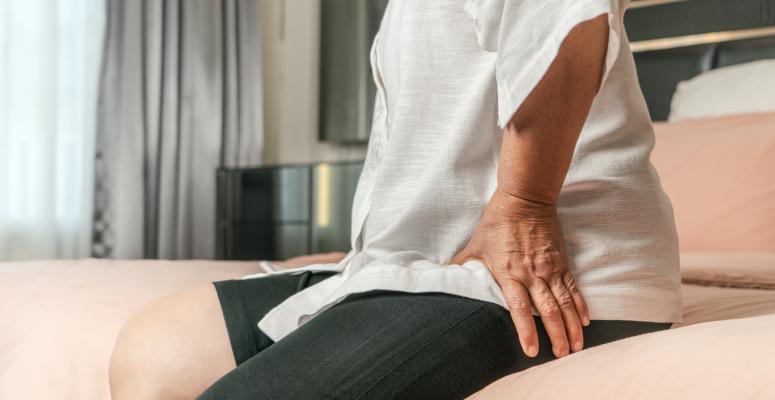
Hip pain is pain or discomfort experienced in or around your hip joint. Your hip joint is a ball-and-socket joint that supports your body weight and allows you to move your upper leg. It is where your thighbone (femur) connects to your pelvis and is one of the largest joints in your body. Pain in your hip is a common issue; it can range from mild to intense and be caused by a variety of issues. However, you can find effective, natural treatment for your hip pain with physical therapy.
What is physical therapy and how can it help hip pain?
Physical therapy is a treatment intended to help relieve pain, improve mobility and strengthen weakened muscles. It is performed by a physical therapist, a highly educated and trained movement expert. It includes certain exercise, hands-on techniques and treatments in different modalities. It is intended to benefit acute and chronic symptoms or conditions and can also help prevent future issues.
Physical therapy for hip pain can help improve your range of motion, strength and mobility. Treatment approaches can vary depending on the issue causing your hip pain. Your physical therapist will design a custom treatment plan for you based on your symptoms and pain level.
Common hip conditions that can cause pain and how physical therapy can help each one
Hip pain isn’t always felt in the hip joint. It can also be felt through the groin and thigh. Pain can be caused by injuries and conditions such as:
- Tendinitis — A common cause of hip pain can be due to tendinitis. It is caused due to the overuse and causes the tendons of the hip to become inflamed. It can be a very painful condition. Soft tissue mobilization can help improve pain from hip tendinitis and help strengthen the tendons.
- Osteoarthritis — Osteoarthritis is the result of age-related wearing down of the cartilage of the joint. This results in the bones grinding together and causing pain and limited mobility. The use of therapeutic ultrasound can be beneficial for helping treat osteoarthritis. It can penetrate deep tissue better than other external heating sources (like a heating pad) and can help with pain.
- Bursitis — The bursae are fluid-filled sacs in joints that help with the lubrication of the joint during movement. These sacs can become inflamed, causing bursitis. It can be as a result of injury, overuse or improper posture. Dry needling physical therapy can help improve your hip pain from bursitis.
- Rheumatoid arthritis — Rheumatoid arthritis is caused by the body’s immune system attacking the body’s joints. This can lead to the deterioration of cartilage and bones, causing pain. Hydrotherapy can be beneficial for hip pain caused by rheumatoid arthritis by allowing you to complete exercises without the added gravity pull felt on land.
- Hip flexor strain — Hip strains can be incredibly painful and have you sitting out from activities. The strain is caused by a tear in your muscle tissue due to injury or overuse. They are common in athletes such as runners; those who do martial arts; and hockey, football, and soccer players. Physical therapy can help you regain strength and mobility in your hip as you recover from a hip flexor strain.
- Iliotibial band syndrome — The iliotibial (IT) band is a tendon that is on the outside of your leg going from your pelvic bone to your knee. It can rub against the bones if it gets too tight. It can cause inflammation in the tendons leading to hip and knee pain. This condition responds well to manual therapy. Gentle stretching exercises can help decrease the tension in the IT band.
- Hip labral tear — A hip labral tear can be due to injury, structural problems or degeneration. Physical therapy exercises to stretch and strengthen hip muscles can help relieve hip pain caused by a hip labral tear.
- Hip impingement — Hip impingement occurs when the head of the femur pinches up against the socket of the pelvis. If left untreated, it can lead to arthritis. Manual therapy can help restore your hip’s range of motion using stretches and strengthening exercises.
- Sciatica — Your hip pain could be caused by referred pain resulting from a herniated disc pressing against your sciatic nerve. This nerve travels through the lower back into the hips and legs. When this nerve is pinched, it can cause pain or numbness ranging from mild to severe. Electrical stimulation physical therapy can help stimulate the nerves and help reduce inflammation and pain. Dry needling and joint mobilizations are two techniques that can be beneficial in helping to release pain experienced from sciatic nerve pain radiating in your hip.
Hip pain may be a common pain complaint, but you don’t have to experience pain longer than necessary. Physical therapy can help you find pain relief and can also help improve your condition.
Alliance PTP can help find expert physical therapists near you to address hip pain
You probably don’t have to go as far as you think to get help with your hip condition. After all, Alliance Physical Therapy Partners has practices across the country where you can find the physical therapy you need.
And if there isn’t one near you, don’t worry! We also offer highly effective and affordable virtual care in nearly every U.S. state.
So, don’t keep letting your symptoms affect your day-to-day life. Get in touch with our team today so we can help you find the physical therapy that’s right for you.
Get Help at a Location Near You
